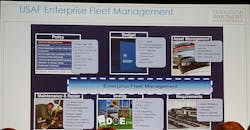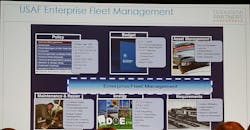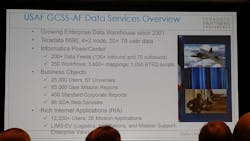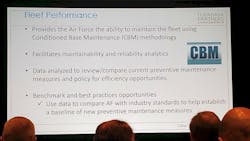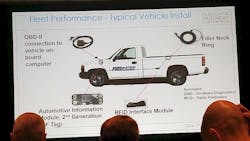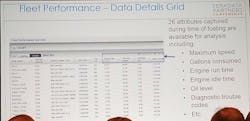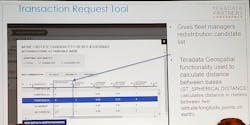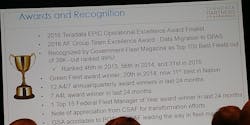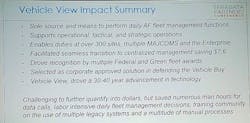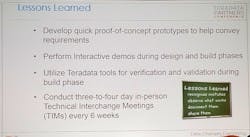U.S. Air Force harnesses data analytics tools to streamline, enhance management of 90,000-vehicle fleet
Teradata PARTNERS Conference, Atlanta. The United States Air Force manages a fleet of more 90,000 vehicles. Air Force bases at home and abroad are like self-contained cities, requiring all types of vehicles, from manned and unmanned aircraft to sedans, snowplows, and fire trucks to refuelers and more. Air Force specialists are harnessing Big Data and all the technology that entails – myriad sensors, cameras, and electro-optics; computers and servers; data storage; networking and communications equipment; cabling and connectors; and advanced software tools – to streamline the management of these assets – on the ground and in the air.
Advanced software, in particular, is helping Air Force personnel capture, manage, and exploit data to track assets and forecast vehicle requirements – and, in the end, saving millions of dollars, winning awards, and – perhaps most importantly – keeping mission- and safety-critical vehicles working reliably worldwide.
Vehicle performance data is captured with on-board diagnostic sensors and loaded for analysis using software from Teradata, provider of end-to-end solutions and services in data warehousing and big data and analytics that enable data-driven businesses, with headquarters in Dayton, Ohio. Specifically, Air Force specialists are using analytic models to prioritize which sets of vehicles to buy, maintain, or replace to optimize the overall fleet health. Use of these tools and a new discovery environment utilizing Teradata Aster Analytics has brought greater insights into the organization, processes, and data that led to Air Force to win such awards as the 2015 Top 100 Best Fleets in North America and the Top 50 Green Fleet Award.
At the Teradata PARTNERS Conference in Atlanta, U.S. Air Force Vehicle Equipment Specialist Robert Uren discussed the defense organization’s use of modern hardware and software to capture and capitalize on valuable data.
The U.S. Air Force, like myriad other aerospace and defense organizations, is evolving – and data capture and data analytics are a big part of that evolution. The Air Force is an example of what is happening across a variety of industry verticals – including government, travel/transportation, airline, manufacturing, and more: uncovering and exploiting the value that lies within data and data repositories (often referred to as data lakes and data warehouses).
“Data-driven Vehicle Management at United States Air Force” was an informative talk delivered at the 2016 Teradata PARTNERS Conference in Atlanta by:
Robert Uren, U.S. Air Force Air Force Vehicle Equipment Specialist
Uren is a United States Air Force (USAF) action officer with over 27 years of Vehicle Management and Analysis experience at Headquarters Air Force, Major Command and Base level. He specializes in enterprise fleet management decisions, system architecture, modernization and development of AF Vehicle Management Information Systems. Currently he works at the USAF 441st Vehicle Support Chain Operations Squadron (VSCOS) . Mr. Uren performs as the Project Manager for requirements, implementation, development, and deployment of the Vehicle View Application, the Vehicle Buy Prioritization and Vehicle Authorization Validation support Models. In 2013, 2014 and 2015, Mr. Uren played a key role in the office being awarded top 100 Best Fleets in North America and the top 50 best Green Fleet Award.
Darrin Gaines, Principal Consultant with Teradata’s Government Systems organization
In 1991, he began working at the San Diego Teradata facility consulting with customers and sales teams on new Teradata technology. Since 1998, Darrin has been active in data warehousing and analytics projects at customers within Insurance, Manufacturing, and Government industries. In 2001, he became one of the first 50 certified Teradata masters worldwide. Since 2007, Darrin has been a frequent speaker at Partners conferences and on the Teradata Education Network. He has presented innovative solutions to real-world problems using features such as Ordered Analytical Functions and Recursive SQL. He is currently consulting on projects at the United States Air Force.
Related information
U.S. Transportation Command accesses accurate, critical data on countless missions
Integrating detailed global intelligence, location information and logistics data in a visual, easy-to-access format is a key enabler of the U.S. Transportation Command (USTRANSCOM), according to retired Gen. John W. Handy, commander of USTRANSCOM from 2001 to 2005. An immense organization, USTRANSCOM is made up of more than 150,000 people stationed worldwide, representing components of the US Army, Navy, Marine Corps, Air Force, Coast Guard, National Guard, Air Force Reserve, and civilian agencies.
"TRANSCOM is responsible for the worldwide distribution of all personnel and equipment in the Department of Defense via air, land and sea modes of transportation," Handy explains. By integrating a staggering amount of information concerning these shipments by way of computer programs, commanders are able to access accurate critical data on countless missions. "Where is my stuff?" becomes just one question that can be answered quickly and factually.
"With a flat-screen TV on the wall of my office and a remote mouse on my desk, I could click on an airplane icon on a map of the world," Handy recalls. This instantly displayed information about the type of aircraft, its maintenance history, a complete list of the crew, the equipment and supplies on the aircraft, where it was going, where it had been, and a history of the entire mission. Similar information is available for ships at sea as well.
Real-time location data, incorporated with other detailed information, empowers USTRANSCOM to make timely, well-informed decisions to coordinate its global operations. — Mike Westholder in Teradata Magazine
Search the Aerospace & Defense Buyer's Guide
You might also like:
Subscribe today to receive all the latest aerospace technology and engineering news, delivered directly to your e-mail inbox twice a week (Tuesdays and Thursdays). Sign upfor your free subscription to the Intelligent Inbox e-newsletter at http://www.intelligent-aerospace.com/subscribe.html.
Connect with Intelligent Aerospace on social media: Twitter (@IntelligentAero), LinkedIn,Google+, and Instagram.
Intelligent Aerospace
Global Aerospace Technology NetworkIntelligent Aerospace, the global aerospace technology network, reports on the latest tools, technologies, and trends of vital importance to aerospace professionals involved in air traffic control, airport operations, satellites and space, and commercial and military avionics on fixed-wing, rotor-wing, and unmanned aircraft throughout the world.
